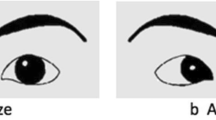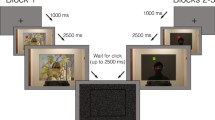Abstract
We investigated the influence of control over a social stimulus on the ability to detect direct gaze in high-functioning autism (HFA). In a pilot study, 19 participants with and 19 without HFA were compared on a gaze detection and a gaze setting task. Participants with HFA were less accurate in detecting direct gaze in the detection task, but did not differ in their ability to establish direct gaze in the setting task. In the main experiment, the results of the pilot study were replicated with 37 participants with and 39 without HFA, suggesting that individuals with HFA have a specific deficit in the passive perception of social cues as opposed to the active control, which seems to be intact.





Similar content being viewed by others
References
Adams, R. B., & Kleck, R. E. (2005). Effects of direct and averted gaze on the perception of facially communicated emotion. Emotion, 5(1), 3–11. doi:10.1037/1528-3542.5.1.3.
Akechi, H., Senju, A., Kikuchi, Y., Tojo, Y., Osanai, H., & Hasegawa, T. (2010). The effect of gaze direction on the processing of facial expressions in children with autism spectrum disorder: An ERP study. Neuropsychologia, 48(10), 2841–2851. doi:10.1016/j.neuropsychologia.2010.05.026.
Ashwin, E., Ashwin, C., Rhydderch, D., Howells, J., & Baron-Cohen, S. (2009). Eagle-Eyed visual acuity: An experimental investigation of enhanced perception in autism. Biological Psychiatry, 65(1), 17–21. doi:10.1016/j.biopsych.2008.06.012.
Baron-Cohen, S. (1988). Social and pragmatic deficits in autism: Cognitive or affective? Journal of Autism and Developmental Disorders, 18(3), 379–402. doi:10.1007/BF02212194.
Baron-Cohen, S. (2009). Autism: The empathizing-systemizing (ES) theory. Annals of the New York Academy of Sciences, 1156(1), 68–80. doi:10.1111/j.1749-6632.2009.04467.x.
Baron-Cohen, S., Ashwin, E., Ashwin, C., Tavassoli, T., & Chakrabarti, B. (2009). Talent in autism: Hyper-Systemizing, hyper-attention to detail and sensory hypersensitivity. Philosophical Transactions of the Royal Society of London. Series B, Biological Sciences, 364(1522), 1377–1383. doi:10.1098/rstb.2008.0337.
Baron-Cohen, S., Hoekstra, R. A., Knickmeyer, R., & Wheelwright, S. (2006). The autism-spectrum quotient (AQ)–adolescent version. Journal of Autism and Developmental Disorders, 36(3), 343–350. doi:10.1007/s10803-006-0073-6.
Baron-Cohen, S., Richler, J., Bisarya, D., Gurunathan, N., & Wheelwright, S. (2003). The systemizing quotient: An investigation of adults with Asperger syndrome or high-functioning autism, and normal sex differences. Philosophical Transactions of the Royal Society of London. Series B, Biological Sciences, 358(1430), 361–374. doi:10.1098/rstb.2002.1206.
Baron-Cohen, S., & Wheelwright, S. (2004). The empathy quotient: An investigation of adults with Asperger syndrome or high functioning autism, and normal sex differences. Journal of Autism and Developmental Disorders, 34(2), 163–175.
Baron-Cohen, S., Wheelwright, S., Hill, J., Raste, Y., & Plumb, I. (2001). The “reading the mind in the eyes” test revised version: A study with normal adults, and adults with asperger syndrome or high-functioning autism. Journal of Child Psychology and Psychiatry and Allied Disciplines, 42(02), 241–251.
Beck, A. T., & Steer, R. A. (1987). Beck depression inventory—manual. San Antonio: The Psychological Association.
Bente, G., Donaghy, W. C., & Suwelack, D. (1998). Sex differences in body movement and visual attention: An integrated analysis of movement and gaze in mixed-sex dyads. Journal of Nonverbal Behavior, 22(1), 31–58. doi:10.1023/a:1022900525673.
Bente, G., Eschenburg, F., & Krämer, N. (2007). Virtual gaze. A pilot study on the effects of computer simulated gaze in avatar-based conversations. Lecture Notes in Computer Science, 4563, 185–194. doi:10.1007/978-3-540-73335-5_21.
Corden, B., Chilvers, R., & Skuse, D. (2008). Avoidance of emotionally arousing stimuli predicts social-perceptual impairment in Asperger’s syndrome. Neuropsychologia, 46(1), 137–147. doi:10.1016/j.neuropsychologia.2007.08.005.
Dawson, G., Meltzoff, A. N., Osterling, J., Rinaldi, J., & Brown, E. (1998). Children with autism fail to orient to naturally occurring social stimuli. Journal of Autism and Developmental Disorders, 28(6), 479–485.
Elsabbagh, M., Volein, A., Csibra, G., Holmboe, K., Garwood, H., Tucker, L., et al. (2009). Neural correlates of eye gaze processing in the infant broader autism phenotype. Biological Psychiatry, 65(1), 31–38. doi:10.1016/j.biopsych.2008.09.034.
Faja, S., Aylward, E., Bernier, R., & Dawson, G. (2008). Becoming a face expert: A computerized face-training program for high-functioning individuals with autism spectrum disorders. Developmental Neuropsychology, 33(1), 1–24. doi:10.1080/87565640701729573.
Farroni, T., Csibra, G., Simion, F., & Johnson, M. H. (2002). Eye contact detection in humans from birth. Proceedings of the National Academy of Sciences of the United States of America, 99(14), 9602–9605. doi:10.1073/pnas.152159999.
Ferrara, C., & Hill, S. D. (1980). The responsiveness of autistic children to the predictability of social and nonsocial toys. Journal of Autism and Developmental Disorders, 10(1), 51–57.
Flannery, K., & Horner, R. H. (1994). The relationship between predictability and problem behavior for students with severe disabilities. Journal of Behavioral Education, 4(2), 157–176.
Frith, U., & de Vignemont, F. (2005). Egocentrism, allocentrism, and Asperger syndrome. Consciousness and Cognition, 14(4), 719–738. doi:10.1016/j.concog.2005.04.006.
Gamer, M., & Hecht, H. (2007). Are you looking at me? Measuring the cone of gaze. Journal of Experimental Psychology: Human Perception and Performance, 33(3), 705–715. doi:10.1037/0096-1523.33.3.705.
Gepner, B., de Gelder, B., & de Schonen, S. (1996). Face processing in autistics: Evidence for a generalised deficit? Child Neuropsychology, 2(2), 123–139.
Gepner, B., Deruelle, C., & Grynfeltt, S. (2001). Motion and emotion: A novel approach to the study of face processing by young autistic children. Journal of Autism and Developmental Disorders, 31(1), 37–45.
Golan, O., Ashwin, E., Granader, Y., McClintock, S., Day, K., Leggett, V., et al. (2009). Enhancing emotion recognition in children with autism spectrum conditions: An intervention using animated vehicles with real emotional faces. Journal of Autism and Developmental Disorders, 40, 269–279. doi:10.1007/s10803-009-0862-9.
Gomot, M., & Wicker, B. (2011). A challenging, unpredictable world for people with autism spectrum disorder. International Journal of Psychophysiology. Advance online publication. doi:10.1016/j.ijpsycho.2011.09.017.
Grice, S. J., Halit, H., Farroni, T., Baron-Cohen, S., Bolton, P., & Johnson, M. H. (2005). Neural correlates of eye-gaze detection in young children with autism. Cortex, 41(3), 342–353.
Hautzinger, M. (1995). Beck-Depressions-Inventar (BDI). Bern: Huber.
Howard, M. A., Cowell, P. E., Boucher, J., Broks, P., Mayes, A., Farrant, A., et al. (2000). Convergent neuroanatomical and behavioural evidence of an amygdala hypothesis of autism. NeuroReport, 11(13), 2931–2935.
Hutt, C., & Ounsted, C. (1966). The biological significance of gaze aversion with particular reference to the syndrome of infantile autism. Behavioral Science, 11(5), 346–356.
Joseph, R. M., Ehrman, K., McNally, R., & Keehn, B. (2008). Affective response to eye contact and face recognition ability in children with ASD. Journal of the International Neuropsychological Society, 14(6), 947–955. doi:10.10170S1355617708081344.
Klin, A., Lin, D. J., Gorrindo, P., Ramsay, G., & Jones, W. (2009). Two-Year-Olds with autism orient to non-social contingencies rather than biological motion. Nature, 459(7244), 257–261. doi:10.1038/nature07868.
Kuzmanovic, B., Georgescu, A. L., Eickhoff, S. B., Shah, N. J., Bente, G., Fink, G. R., et al. (2009). Duration matters: Dissociating neural correlates of detection and evaluation of social gaze. NeuroImage, 46(4), 1154–1163. doi:10.1016/j.neuroimage.2009.03.037.
Kylliäinen, A., & Hietanen, J. K. (2006). Skin conductance responses to another person’s gaze in children with autism. Journal of Autism and Developmental Disorders, 36(4), 517–525. doi:10.1007/s10803-006-0091-4.
Lehnhardt, F. G., Gawronski, A., Volpert, K., Schilbach, L., Tepest, R., Huff, W., et al. (2011). Autismus-Spektrum-Stöhrungen im Erwachsenenalter: Klinische und neuropsychologische Befunde spätdiagnostizierter Asperger-Syndrome. Fortschritte der Neurologie und Psychiatrie, 79, 290–297.
Loth, E., Happé, F., & Gómez, J. C. (2010). Variety is not the spice of life for people with autism spectrum disorders: Frequency ratings of central, variable and inappropriate aspects of common real-life events. Journal of Autism and Developmental Disorders, 40(6), 730–742. doi:10.1007/s10803-009-0929-7.
Martin, W., & Rovira, M. (1982). Response biases in eye-gaze perception. Journal of Psychology: Interdisciplinary and Applied, 110(2), 203–209.
Myowa-Yamakoshi, M., Tomonaga, M., Tanaka, M., & Matsuzawa, T. (2003). Preference for human direct gaze in infant chimpanzees (pan troglodytes). Cognition, 89(2), 53–64.
Nation, K., & Penny, S. (2008). Sensitivity to eye gaze in autism: Is it normal? Is it automatic? Is it social? Development and Psychopathology, 20(1), 79–97. doi:10.1017/S0954579408000047.
Pitskel, N. B., Bolling, D. Z., Hudac, C. M., Lantz, S. D., Minshew, N. J., Vander Wyk, B. C., et al. (2011). Brain mechanisms for processing direct and averted gaze in individuals with autism. Journal of Autism and Developmental Disorders. Advance online publication. doi:10.1007/s10803-011-1197-x.
Qian, N., & Lipkin, R. M. (2011). A learning-style theory for understanding autistic behaviors. Frontiers in Human Neuroscience, 5, 1–17. doi:10.3389/fnhum.2011.00077.
Richer, J. M., & Coss, R. G. (1976). Gaze aversion in autistic and normal children. Acta Psychiatrica Scandinavica, 53(3), 193–210.
Ristic, J., Mottron, L., Friesen, C. K., Iarocci, G., Burack, J. A., & Kingstone, A. (2005). Eyes are special but not for everyone: The case of autism. Cognitive Brain Research, 24(3), 715–718. doi:10.1016/j.cogbrainres.2005.02.007.
Sanefuji, W., & Ohgami, H. (2011). Imitative behaviors facilitate communicative gaze in children with autism. Infant Mental Health Journal, 32(1), 134–142. doi:10.1002/imhj.20287.
Schilbach, L., Eickhoff, S. B., Cieslik, E. C., Kuzmanovic, B., & Vogeley, K. (2011). Shall we do this together? Social gaze influences action control in a comparison group, but not in individuals with high-functioning autism. Autism. Advance online publication. doi:10.1177/1362361311409258.
Senju, A., Hasegawa, T., & Tojo, Y. (2005). Does perceived direct gaze boost detection in adults and children with and without autism? The stare-in-the-crowd effect revisited. Visual Cognition, 12(8), 1474–1496. doi:10.1080/13506280444000797.
Senju, A., & Johnson, M. H. (2009). The eye contact effect: Mechanisms and development. Trends in Cognitive Sciences, 13(3), 127–134. doi:10.1016/j.tics.2008.11.009.
Senju, A., Kikuchi, Y., Hasegawa, T., Tojo, Y., & Osanai, H. (2008). Is anyone looking at me? Direct gaze detection in children with and without autism. Brain and Cognition, 67(2), 127–139. doi:10.1016/j.bandc.2007.12.001.
Senju, A., Yaguchi, K., Tojo, Y., & Hasegawa, T. (2003). Eye contact does not facilitate detection in children with autism. Cognition, 89(1), 43–51.
Stewart, M. E., Barnard, L., Pearson, J., Hasan, R., & O’Brien, G. (2006). Presentation of depression in autism and Asperger syndrome: A review. Autism, 10(1), 103–116. doi:10.1177/1362361306062013.
Swettenham, J., Plaisted, K., Milne, E., Campbell, R., Rosenfelder, D., & Coleman, M. (2001). Children with autism show subtle difficulties detecting eye direction. Paper Presented at the Annual Meeting of the Cognitive Neuroscience Society, New York, NY.
Tewes, U. (1994). Hamburg-Wechsler-Intelligenztest für Erwachsene, Revision 1991. Bern: Huber.
Von Aster, M., Neubauer, A., & Horn, R. (2006). Wechsler Intelligenztest für Erwachsene (WIE). Deutschsprachige Bearbeitung und Adaption des WAIS-III von David Wechsler. Frankfurt: Harcourt Test Services.
Wallace, S., Coleman, M., Pascalis, O., & Bailey, A. (2006). A study of impaired judgment of eye-gaze direction and related face-processing deficits in autism spectrum disorders. Perception, 35(12), 1651–1664. doi:10.1068/p5442.
Webster, S., & Potter, D. D. (2011). Gaze perception develops atypically in children with autism. Child Development Research. Advance online publication. doi:10.1155/2011/462389.
Wheelwright, S., Baron-Cohen, S., Goldenfeld, N., Delaney, J., Fine, D., Smith, R., et al. (2006). Predicting autism spectrum quotient (AQ) from the systemizing quotient-revised (SQ-R) and empathy quotient (EQ). Brain Research, 1079(1), 47–56. doi:10.1016/j.brainres.2006.01.012.
Wilms, M., Schilbach, L., Pfeiffer, U., Bente, G., Fink, G. R., & Vogeley, K. (2010). It’s in your eyes–using gaze-contingent stimuli to create truly interactive paradigms for social cognitive and affective neuroscience. Social Cognitive and Affective Neuroscience, 5(1), 98–107. doi:10.1093/scan/nsq024.
Acknowledgments
This work was supported by a project grant of the German Ministry of Education and Research (BMBF “Social Gaze: Phenomenology and neurobiology of dysfunctions in high-functioning autism (HFA)”) to Gary Bente and Kai Vogeley.
Author information
Authors and Affiliations
Corresponding author
Rights and permissions
About this article
Cite this article
Dratsch, T., Schwartz, C., Yanev, K. et al. Getting a Grip on Social Gaze: Control over Others’ Gaze Helps Gaze Detection in High-Functioning Autism. J Autism Dev Disord 43, 286–300 (2013). https://doi.org/10.1007/s10803-012-1569-x
Published:
Issue Date:
DOI: https://doi.org/10.1007/s10803-012-1569-x




